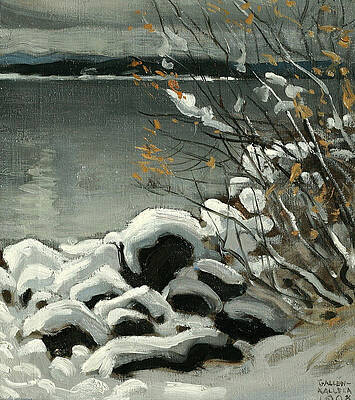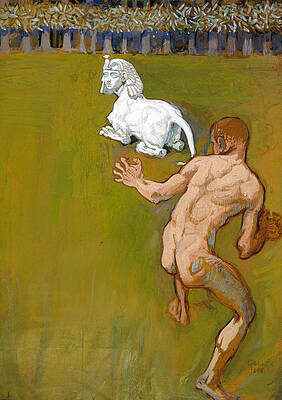Akseli Gallen-Kallela
Paintings
Lake Keitele
Snowy Landscape
Nude Model
Mother and Child
Ice Breaking-up on Lake Ruovesi
Sunset over Lake Ruovesi
Rustic Life
Forging of the Sampo
Spring Sun at Konginkangas
Conceptio artis
Snowy Pine-Tree
Boy with a Crow
Great Black Woodpecker
Burnt Forest

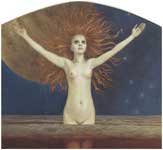
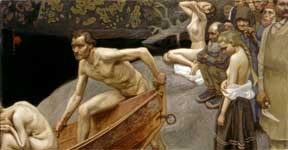
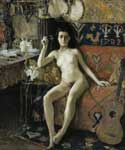
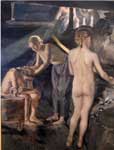
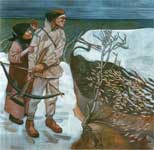
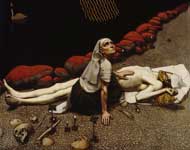
Fine Art Prints | Greeting Cards | Phone Cases | Lifestyle | Face Masks | Men's , Women' Apparel | Home Decor | jigsaw puzzles | Notebooks | Tapestries | ...
Snowy Pine-Tree
Akseli Gallen-Kallela (26 April 1865 – 7 March 1931) was a Swedish-speaking Finnish painter who is best known for his illustrations of the Kalevala, the Finnish national epic (illustration, below). His work was considered very important for the Finnish national identity. He changed his name from Gallen to Gallen-Kallela in 1907.
Life
The Defense of the Sampo, 1896, Turku Art Museum
The Aino triptych, 1891
Gallen-Kallela was born Axel Waldemar Gallén in Pori, Finland in a Swedish-speaking family. His father Peter Gallén worked as police chief and lawyer.[1] At the age of 11 he was sent to Helsinki to study at a grammar school, because his father opposed his ambition to become a painter. After his father's death in 1879, Gallen-Kallela attended drawing classes at the Finnish Art Society (1881-4) and studied privately under Adolf von Becker.
In 1884 he moved to Paris, to study at the Académie Julian.[2] In Paris he became friends with the Finnish painter Albert Edelfelt, the Norwegian painter Adam Dörnberger, and the Swedish writer August Strindberg.
He married Mary Slöör in 1890. The couple had three children, Impi Marjatta, Kirsti and Jorma. On their honeymoon to East Karelia, Gallen-Kallela started collecting material for his depictions of the Kalevala. This period is characterized by romantic paintings of the Kalevala, like the Aino triptych, and by several landscape paintings.
In December 1894, Gallen-Kallela moved to Berlin to oversee the joint exhibition of his works with the works of Norwegian painter Edvard Munch. Here he became acquainted with the Symbolists.
In March 1895, he received a telegram that his daughter Impi Marjatta had died from diphtheria. This would prove to be a turning point in his work. While his works had previously been romantic, after his daughter's death Gallen-Kallela painted more aggressive works like the Defense of the Sampo, Joukahainen's Revenge, Kullervo Cursing and Lemminkäinen's Mother.
On his return from Germany, Gallen studied print-making and visited London to deepen his knowledge, and in 1898 studied fresco-painting in Italy.
Career
Joukahainen's Revenge, 1897
For the Paris World Fair in 1900, Gallen-Kallela painted frescoes for the Finnish Pavilion. In these frescoes, his political ideas became most apparent. One of the vipers in the fresco Ilmarinen Plowing the Field of Vipers is wearing the Romanov crown, and the process of removing the vipers from the field was a clear reference to his wish for an independent Finland.
The Paris Exposition secured Gallen-Kallela's stature as the leading Finnish artist.[3] In 1901 he was commissioned to paint the fresco, Kullervo Goes to War, for the concert hall of the Helsinki Student's Union.[3] Between 1901 and 1903 he painted the frescoes for the Jusélius Mausoleum in Pori, memorializing the 11-year-old daughter of the industrialist F.A. Jusélius. (The frescoes were soon damaged by dampness, and were completely destroyed by fire in December 1931. Jusélius assigned the artist's son Jorma to repaint them from the original sketches.[4] The reconstruction was completed just before Jorma's death in 1939.)
Gallen-Kallela officially finnicized his name to the more Finnish-sounding Akseli Gallen-Kallela in 1907.
Kallela Museum
In 1909, Gallen-Kallela moved to Nairobi in Kenya with his family, and there he painted over 150 expressionist oil-paintings and bought many east African artefacts. But he returned to Finland after a couple of years, because he realized Finland was his main inspiration. Between 1911 and 1913 he designed and built a studio and house at Tarvaspää, about 10 km northwest of the centre of Helsinki.[5]
In 1918, Gallen-Kallela and his son Jorma took part in the fighting at the front of the Finnish Civil War. When the regent, General Mannerheim, later heard about this, he invited Gallen-Kallela to design the flags, official decorations and uniforms for the newly independent Finland. In 1919 he was appointed aide-de-camp to Mannerheim.
From December 1923 to May 1926, Gallen-Kallela lived in the United States, where an exhibition of his work toured several cities.,[6] and where he visited the Taos art-colony in New Mexico to study indigenous American art. In 1925 he began the illustrations for his "Great Kalevala". This was still unfinished when he died of pneumonia in Stockholm on 7 March 1931, while returning from a lecture in Copenhagen, Denmark.
His studio and house at Tarvaspää was opened as the Gallen-Kallela Museum in 1961; it houses some of his works and research facilities on Gallen-Kallela himself.
Paintings
Akseli Gallen-Kallela - Kullervo Cursing, 1899, oil on canvas
Boy with a Crow (Poika ja varis) (1884)
The Old Woman and the Cat (Akka ja kissa) (1885)
Démasquée (fr) (1888)
Ahlström family (1890)
The Aino triptych (Aino-taru) (1891)
Mäntykoski Waterfall (1892)
A Winter Scene From Imatra (1893)
The Forging of the Sampo (Sammon taonta) (1893)
Jean Sibelius (1894)
Lake Ruovesi (1896), at the Pushkin Museum of Fine Arts in Moscow
The Defense of the Sampo (Sammon puolustus) (1896)
Lemminkäinen's Mother (Lemminkäisen äiti) (1897)
Moonlit Night (1897), at the Pushkin Museum of Fine Arts in Moscow
The Fratricide (Velisurmaaja) (1897)
Joukahainen's Revenge (Joukahaisen kosto) (1897)
Symposion (1894)
Kullervo's Curse (Kullervon kirous) (1899)
Kullervo Rides to War (Kullervon sotaanlähtö) (1901)
Lake Keitele[7] (1905), at the National Gallery in London
Ad Astra (1907)
Väinämöinen's Boat Journey (1909)
Notes
Martin, T. & Pusa, E. 1985, p. 5.
Martin, T. & Pusa, E. 1985, p. 6.
Martin, T. & Pusa, E. 1985, p. 12.
Martin, T. & Pusa, E. 1985, p. 37.
Martin, T. & Pusa, E. 1985, p. 38; gallen-kallela.fi
Martin, T. & Pusa, E. 1985, p. 39.
Nationalgallery.org.uk
References
Akseli Gallen-Kallela, De magie van Finland, Groninger Museum, NAI Uitgevers, 2006, ISBN 90-5662-524-1
Martin, T. & Pusa, E., Akseli Gallen-Kallela, 1865-1931 / Erja Pusa [translation: John Derome]. Tarvaspää: Gallen-Kallela Museum, 1985. OCLC 29071282
----
Fine Art Prints | Greeting Cards | Phone Cases | Lifestyle | Face Masks | Men's , Women' Apparel | Home Decor | jigsaw puzzles | Notebooks | Tapestries | ...
----
Artist
A - B - C - D - E - F - G - H - I - J - K - L - M -
N - O - P - Q - R - S - T - U - V - W - X - Y - Z
Retrieved from "http://en.wikipedia.org/"
All text is available under the terms of the GNU Free Documentation License




